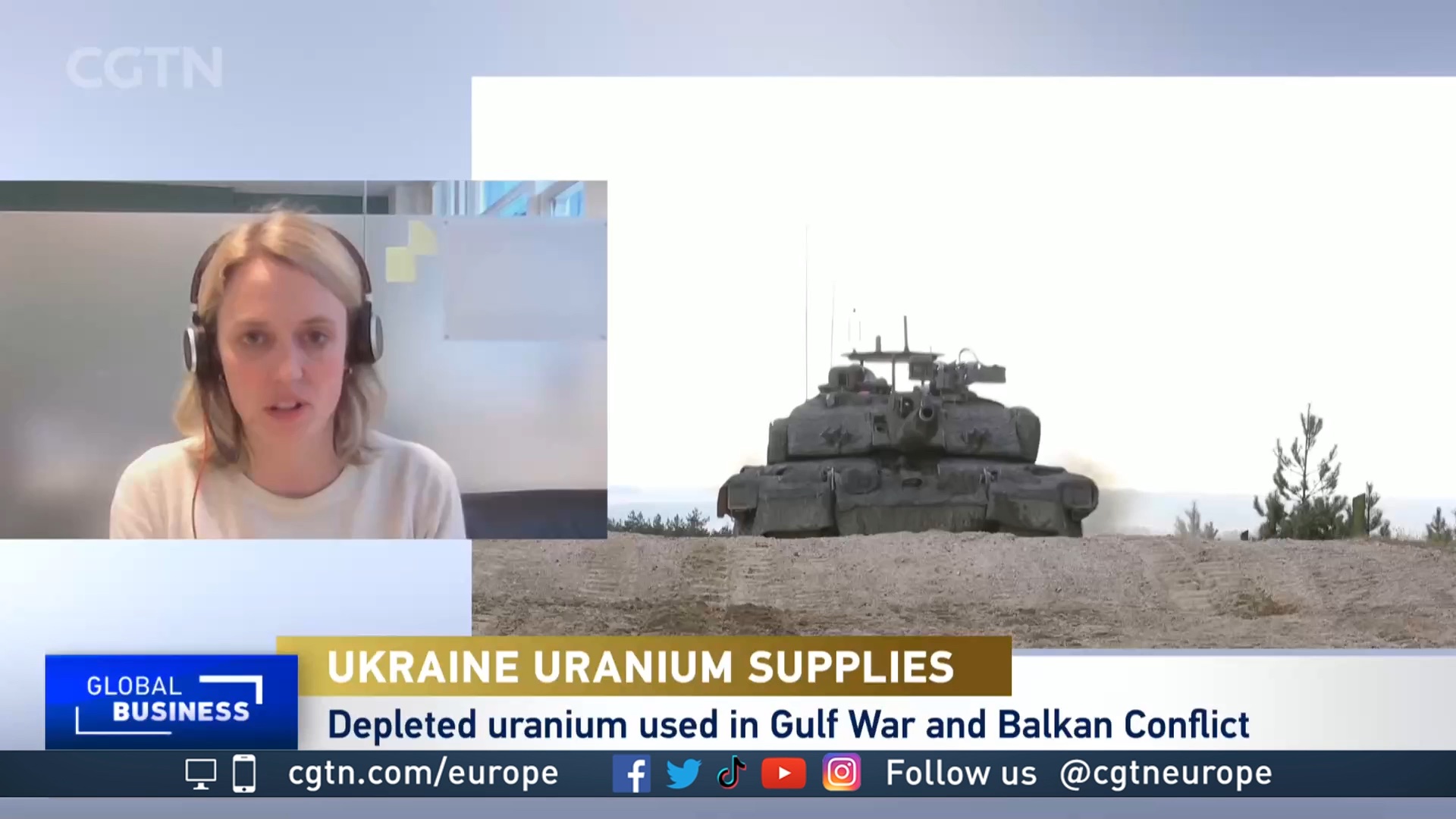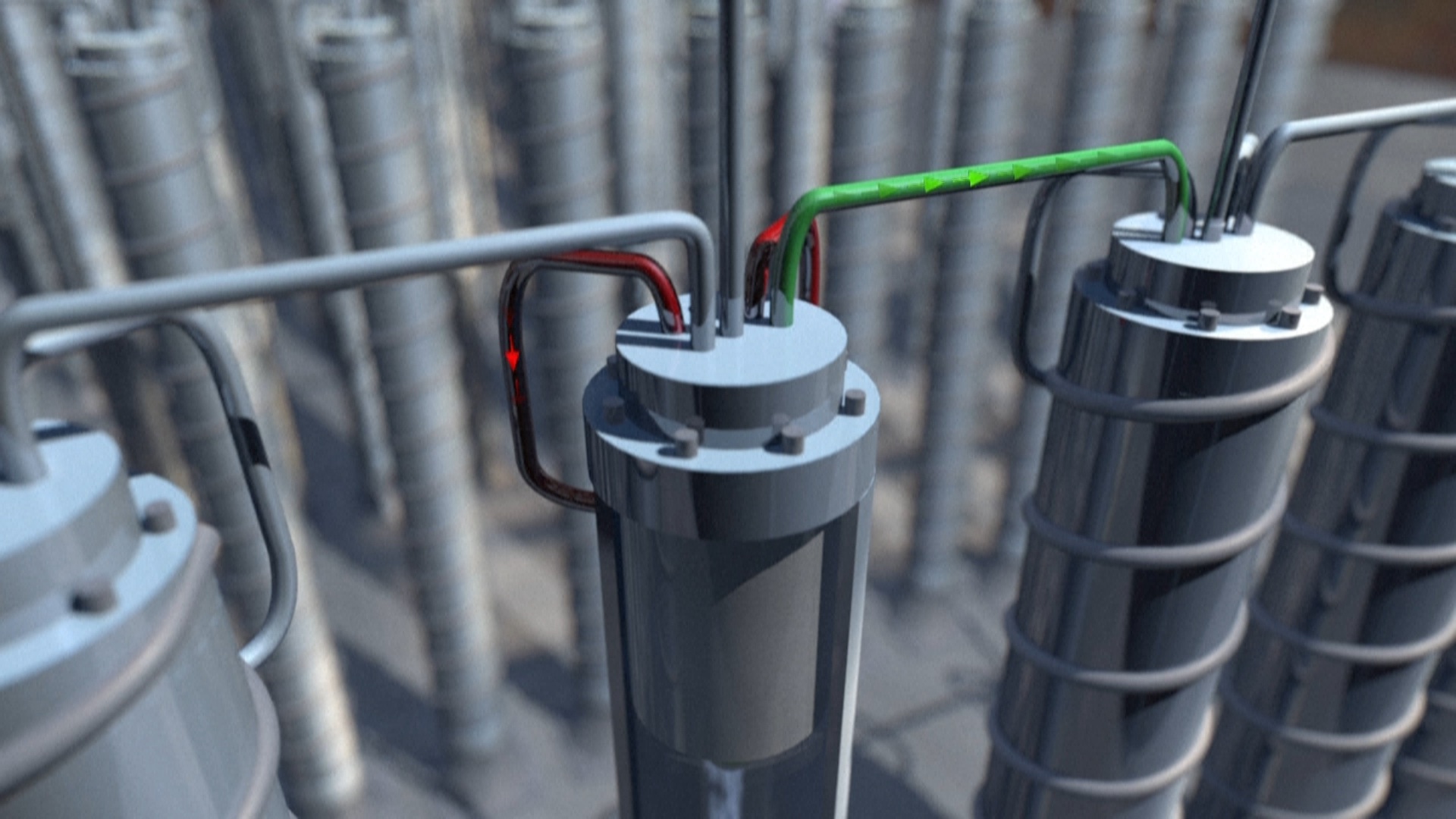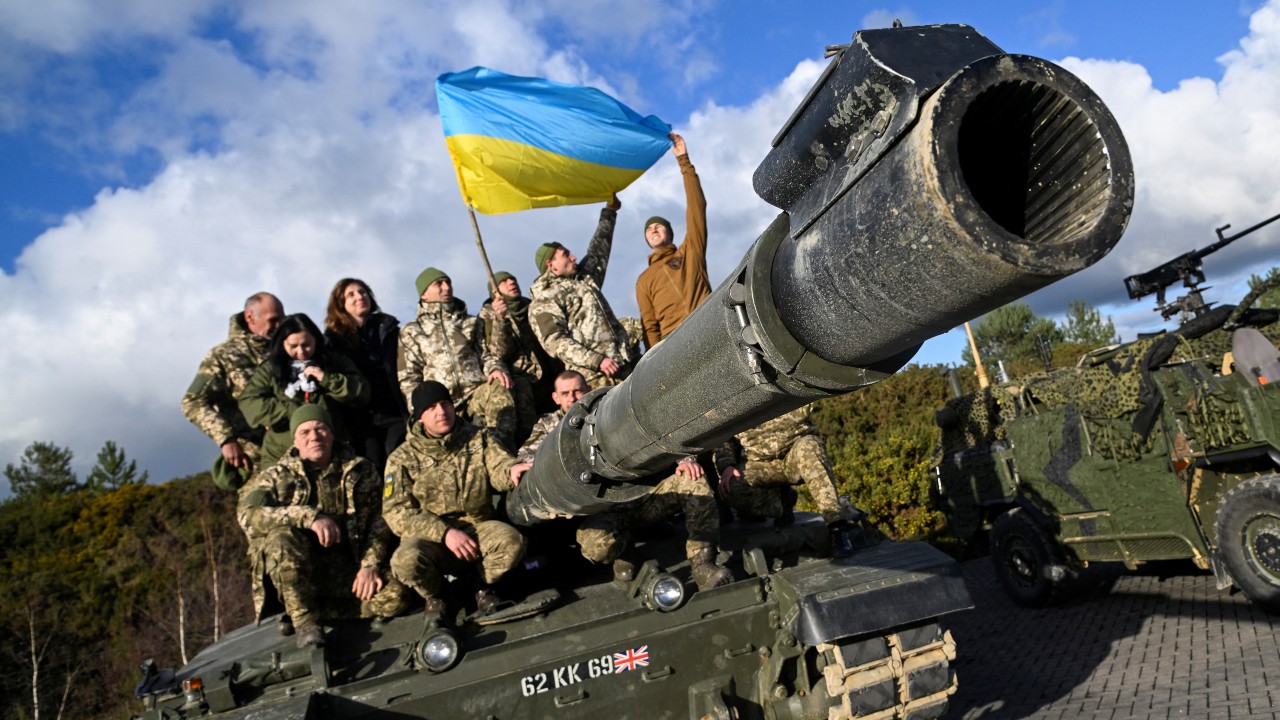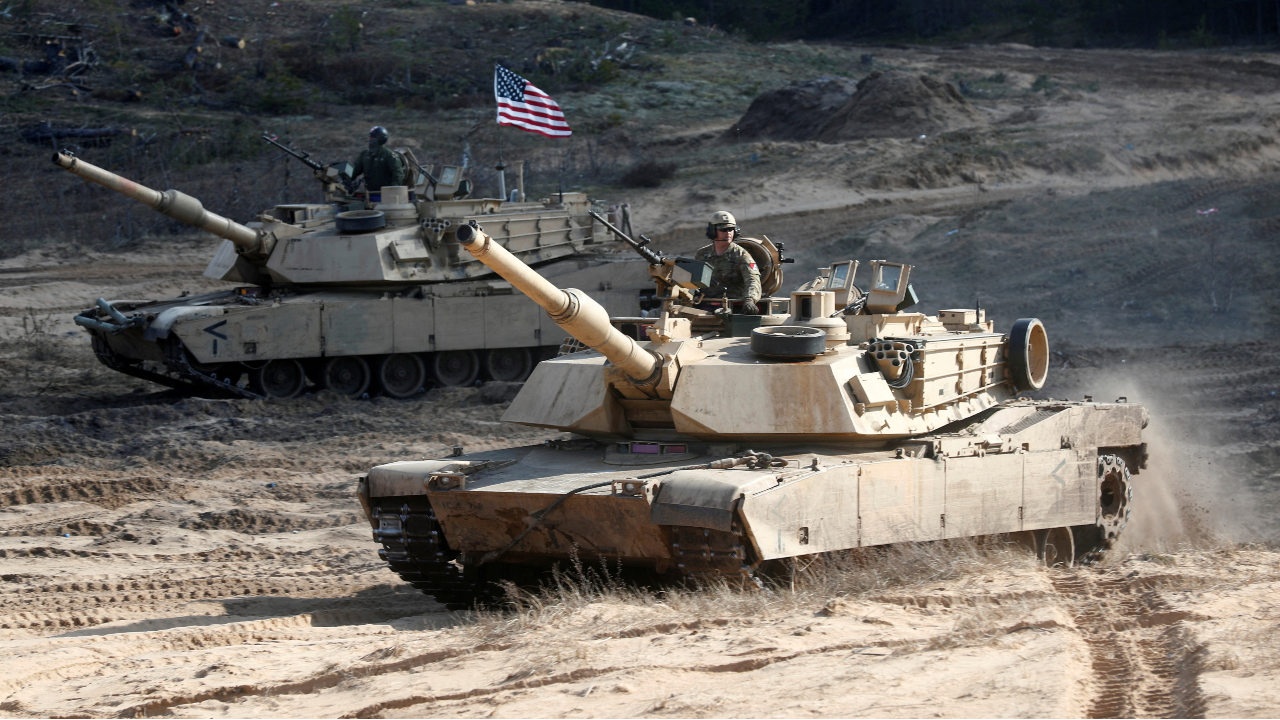05:58

Besides fears arising from escalating conflicts, some experts have reiterated concerns over the effects of depleted uranium. The Campaign for Nuclear Disarmament has warned of the "additional environmental and health disaster" possible from toxic or radioactive dust being released on impact of weapons containing the substance.
The confusion arises from the nature of depleted uranium. Is it a nuclear weapon, by definition or in effect? What is it used for and what does it do?
In this explainer, CGTN Europe will try to answer all these questions and more.

Depleted uranium is a byproduct of creating enriched uranium. /AFP
Depleted uranium is a byproduct of creating enriched uranium. /AFP
What is depleted uranium?
Uranium comes in different types and isotopes, but the really useful stuff is uranium-235, which is fissile – that is, capable of maintaining a nuclear fission chain reaction – and is therefore the engine behind both nuclear weapons and nuclear power.
Uranium-235 (or 235U) is irritatingly rare, but during the 1940s scientists working on nuclear weaponry discovered they could create 'enriched uranium' with heavier concentrations of the 235U isotopes. Enriched uranium is what makes nuclear submarines move, nuclear power stations generate and nuclear bombs explode.
The process of creating enriching uranium makes a by-product called depleted uranium – depleted of its 235U, therefore less reactive and indeed less radioactive. For decades it was stored in the hope that it would be rendered useful by improved enrichment processes, but depleted uranium was to receive a quicker way back to utility – and again, it came through military technology.
Depleted uranium is dense – 1.67 times as dense as lead – making it good for the military in two very oppositional ways: Dense projectiles can pierce armor, and dense armor can deflect projectiles.
It's that density, industry analyst Louise Jones tells CGTN, that attracts the military. "That property – which has nothing to do with the fact that it was used for uranium – means it's very effective to use in a warhead," says Jones, Head of Intelligence at McKenzie Intelligence Services.
"For the size and weight of the metal, you have a very effective penetrative weapon to be used against anti-armor or anti-tank. And that's why it's used – it's nothing to do with any small radioactive components that it may have."
Depleted uranium has been used in armor-piercing ordnance since at least the 1990 Gulf War, while it is now also used in armor plating for tanks: the U.S. M1A1 Abrams battle tank has been equipped with it since the late 1980s.
"In theory, any country that has a nuclear fuel industry can produce depleted uranium," explains Jones. "The use of it on the warheads is mostly done by the U.S. and the UK, where it's been a common standard components of anti-armor tank ammunition since 1990. Countries like Russia have also got access to depleted uranium and have used it on their own anti-armor ammunition as well."
Is depleted uranium a nuclear weapon?
Not according to the UN Institute for Disarmament Research, which says that depleted uranium does not meet the legal definitions of nuclear, radiological, toxin, chemical, poison or incendiary weapons.
Jones is also insistent that the mention of uranium may create a false impression: "This shouldn't be considered in any way similar to a radioactive weapon. The U.N. doesn't classify it as anywhere near the threshold for a nuclear or chemical weapon. Really, it's a conventional weapon that has some characteristics of very low radioactivity."
"The British Army has used depleted uranium in its armor-piercing shells for decades. It is a standard component and has nothing to do with nuclear weapons or capabilities. Russia knows this but is deliberately trying to disinform."
UK Foreign Secretary James Cleverly underlined the difference: "It's worth making sure everyone understands that just because the word uranium is in the title of depleted uranium munitions, they are not nuclear munitions, they are purely conventional munitions."
Can depleted uranium be used to make nuclear weapons?
No. As its name suggests, depleted uranium has been processed to collect the 235U isotopes that make a chain reaction happen.
Or as Hamish de Bretton-Gordon, former commander of the UK's Royal Tank Regiment, said: "Depleted uranium is completely inert. There is no way that you could create a nuclear reaction or a nuclear explosion with depleted uranium."

Ukrainian personnel pose with a flag atop a British Challenger 2 tank, which fires munitions incorporating depleted uranium. /Toby Melville/Reuters
Ukrainian personnel pose with a flag atop a British Challenger 2 tank, which fires munitions incorporating depleted uranium. /Toby Melville/Reuters
What is depleted uranium used for?
Shielding and weight, usually, because of its density. Besides its military applications, it has a few carefully-selected civilian applications.
It is used for radiation shielding in medical radiotherapy and industrial radiography – think of the shields that medics stand behind when giving you an X-ray – and in containers for transporting radioactive materials. It's also used in aircraft for counterweighting, because you don't want an unbalanced aircraft.
What about the AUKUS nuclear submarines deal?
The agreement by which the U.S. and UK will develop nuclear-powered submarines for Australia is groundbreaking and controversial for many reasons, which we've gone into here. However, it has nothing to do with depleted uranium.
Instead, and briefly, the deal is controversial precisely because it involves submarines powered by nuclear reactors – which, you'll remember from earlier paragraphs, are powered by enriched uranium, and that transfer of enriched uranium has never previously happened from a nuclear state (such as the U.S. and UK) to a non-nuclear state (Australia). But that's a different story.
READ MORE: Explainer: What exactly is the AUKUS submarine deal?
What are the dangers of depleted uranium?
Depleted uranium is less radioactive than 'standard' or especially enriched uranium. Its main radioactive emission is alpha particles, which don't have enough energy to pass through the skin.
But that doesn't mean it's safe. The UN Office for Disarmament Affairs describes depleted uranium as "a toxic heavy metal," which "possesses the same chemical toxicity properties as uranium, although its radiological toxicity is less."
The chemical/radiological distinction is important because depleted uranium munitions explode upon impact and release uranium oxide dust, and those alpha particles that can't penetrate your skin can still be ingested by swallowing or inhalation.
Russia's Foreign Ministry spokeswoman Maria Zakharova referenced this when calling the UK's munition exports a "Yugoslavia scenario," saying the ammunition caused cancer and infected the environment.

The U.S. M1A1 Abrams tanks include depleted-uranium armor plating. /Ints Kalnins/Reuters
The U.S. M1A1 Abrams tanks include depleted-uranium armor plating. /Ints Kalnins/Reuters
The International Atomic Energy Agency warns that "sufficient amounts" of ingested depleted uranium can be dangerous because of this "chemical toxicity." One potential effect is kidney failure, while cancer is always a possibility with radioactive material.
"Just being in the vicinity of it whilst it's part of a warhead that hasn't been used doesn't really have any discernible effect," industry expert Jones tells CGTN. "The issues may come from where it then becomes present in aerosols after an explosion – for example, in the vicinity after it has been used on it on a target.
"There's also some discussion about the effects after an explosion on soil or the nearby groundwater. And those after-effects are slightly less clear."
This could be a major concern with Ukraine hoping to reclaim its place as Europe's breadbasket as part of its economic recovery.
Some countries, including Belgium, have already banned the use of uranium in ammunition. The Campaign for Nuclear Disarmament (CND) has responded to the story by insisting the UK government should "introduce an immediate moratorium" on depleted uranium in ammunition, support a global ban on its use in conventional weapons, and pledge to clean up areas where such munitions have been used.
"CND has repeatedly called for the UK government to place an immediate moratorium on the use of depleted uranium weapons and to fund long-term studies into their health and environmental impacts," said CND's general secretary Kate Hudson.
However, the UK's defense ministry insists: "Independent research by scientists from groups such as the Royal Society has assessed that any impact to personal health and the environment from the use of depleted uranium munitions is likely to be low."
Subscribe to Storyboard: A weekly newsletter bringing you the best of CGTN every Friday